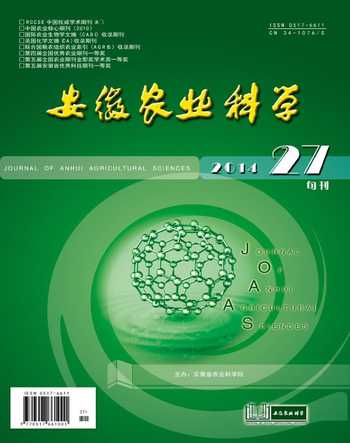资源化利用鸭粪制备活性炭的研究
2014-04-29曹伟王晓雪贾斌陈龙钟成华
曹伟 王晓雪 贾斌 陈龙 钟成华
摘要 [目的] 探讨鸭粪作为活性炭制备原料的资源化利用可行性。[方法] 以鸭粪为原料,采用氢氧化钾为活化剂制备活性炭,以碘吸附值和亚甲基蓝吸附值为评价指标,研究鸭粪活性炭制备过程中固液比、活化剂浓度、活化时间、活化温度等因素对活性炭产率和吸附性能的影响。[结果] 鸭粪活性炭最佳制备工艺条件:固液比为1∶2.5、KOH浓度为40%、活化时间为45 min、活化温度为800 ℃,其活性炭产率、碘吸附值和亚甲基蓝吸附值分别为32.3%、388 mg/g和53 ml/g。在最佳制备工艺条件下添加25%的锯木屑,能明显提高活性炭的吸附性能。[结论] 该研究结果为鸭粪的资源化利用提供了一种新型环保的技术。
关键词 资源化;鸭粪;活性炭;制备
中图分类号 S181.3;X713 文献标识码 A 文章编号 0517-6611(2014)27-09495-04
Study on the Preparation of Activated Carbon from Duck Manure
CAO Wei1,WANG Xiaoxue2, JIA Bin1, ZHONG Chenghua3* et al
(1.Environment Monitoring Station of Dianjiang County, Chongqing 408300; 2.Nanan District Environmental Monitoring Station of Chongqing, Chongqing 400060; 3. School of Environmental and Biological Engineering, Chongqing Technology and Business University, Chongqing 400067)
Abstract [Objective] The research aimed to study the feasibility of activated carbon preparation using duck manure in a resource utilization way.[Method] Activated carbon was prepared from duck manure using KOH as the activator. The performance of the samples was evaluated by adsorption of iodine and methylene blue. The effects of different preparation conditions on the yield and adsorption performance of the samples were studied, including the impregnation ratio, concentration of activators, activation time and activation temperature.[Result] The results showed that the best preparation conditions of impregnation ratio, KOH mass fraction, activation time and activation temperature were 1∶2.5, 40%, 45 min and 800 ℃, respectively. The corresponding yield, iodine and methylene blue adsorption value were 32.3%, 388 mg/g and 53 ml/g, respectively. In addition, the adsorption performance could be improved by adding 25% wood sawdust. [Conclusion] This study could provide new technology for resource utilization of duck manure.
Key words Resource; Duck manure; Activated carbon; Preparation
随着我国农业经济重心从种植业向畜牧业转移,畜牧业逐渐成为农村经济新的增长点和重要的支柱产业[1-2]。但是,由于普遍存在规划不合理以及“农牧脱节”的现状,大量的畜禽粪便不能实现资源化综合利用,造成严重的水体、土壤和大气污染,危害人类身体健康,带来一系列的环境和社会问题。畜禽养殖业已经成为一个不可忽视的污染源,同时也制约着农村经济的可持续发展。因此,为了实现畜禽养殖业的可持续健康发展,必须要对畜禽粪便实现资源化利用和合理处理[3-4]。
研究表明,鸭粪中含有较为丰富的有机质和其他营养物质,这使得资源化利用鸭粪来制备活性炭成为可能。并且,鸭粪的资源化利用不再仅仅局限于制作肥料、饲料和燃料,用来制作活性炭将成为一种新的资源化途径。
为此,该研究选用KOH作为活化剂,主要研究了固液比、活化时间、活化剂浓度、活化温度对鸭粪活性炭产率和吸附性能的影响。
1 材料与方法
1.1 原料、试剂与仪器
鸭粪,取自重庆市九龙坡区梁滩河段某规模化畜禽养殖场。
氢氧化钾、硫代硫酸钠、亚甲基蓝和硫酸铜均为分析纯。
仪器:AL104电子天平(瑞士梅特勒-托利多仪器公司),MFL2000马弗炉(天津市华北实验仪器有限公司),DHG9070A电热恒温鼓风干燥箱(上海齐欣科学仪器有限公司),UV3100PC紫外-可见分光光度计(上海美谱达仪器有限公司),SHZ88A往复式水浴恒温振荡器(江苏汉康电子有限公司)。
1.2 鸭粪活性炭的制备 采用鸭粪制备活性炭主要包括以下几个步骤(如图1):①将新鲜鸭粪在105 ℃条件下烘干,将干燥的鸭粪研磨且过40目筛备用;②取一定质量的干燥鸭粪与不同浓度的氢氧化钾活化剂按不同的固液比混合均匀,浸渍一段时间;③将浸渍均匀的试验样品放入马弗炉中,在400 ℃下碳化60 min,继续升温到一定温度活化,并保持一定时间;④将活化后产物先用稀盐酸清洗,促使其中的氧化物和杂质充分溶解,再用80 ℃左右的蒸馏水反复洗涤至中性,过滤,然后在105 ℃下干燥24 h,最后经研磨、过筛后备用。
1.3 碘吸附值的测定
按照GB/T12496.81999进行测定。称取干燥试样0.5 g,放入100 ml碘量瓶中,加入(1+9)盐酸10.0 ml,在电炉上加热至沸,微沸(30±2) s,冷却至室温后,加入50.0 ml的0.1 mol/L碘标准溶液,在振荡机上振荡15 min,过滤到干燥烧杯中。用移液管吸取10.0 ml滤液,放入250 ml碘量瓶中,加入100 ml水,用0.1 mol/L硫代硫酸钠标准溶液进行滴定,在溶液呈淡黄色时,加2 ml淀粉指示液,继续滴定使溶液变成无色,记录下使用的硫代硫酸钠体积。
3 结论
(1)以鸭粪为原料,采用氢氧化钾活化法制备活性炭,以碘吸附值和亚甲基蓝吸附值为评价指标,探索了制备过程中固液比、活化剂浓度、活化时间、活化温度等因素对鸭粪活性炭吸附性能的影响。
(2)通过单因素试验和正交试验,确定了鸭粪活性炭的最佳制备工艺条件为:固液比1∶2.5、KOH浓度40%、活化时间45 min和活化温度800 ℃,在该条件下制备的活性炭产率、碘吸附值和亚甲基蓝吸附值分别为32.3%、388 mg/g和53 ml/g。
(3)鸭粪活性炭制备过程中各因素对产品产率和吸附性能影响程度大小排序:
产率是活化温度>KOH浓度>固液比>活化时间;
碘吸附值是固液比>活化温度>KOH浓度>活化时间;
亚甲基蓝吸附值是固液比>活化温度>KOH浓度>活化时间。
(4)探索了通过添加锯木屑来提高鸭粪活性炭的吸附性能。在最佳制备工艺条件下添加25%的锯木屑时,能明显提高活性炭的吸附性能,并且在该条件下制备的活性炭产率、碘吸附值和亚甲基蓝吸附值分别为34.5%、545 mg/g和65 ml/g。
参考文献
[1] 李庆康,吴雷,刘海琴,等.我国集约化畜禽养殖场粪便处理利用现状及展望[J].农业环境保护,2000,19(4):251-254.
[2] 孟祥海,张俊飚,李鹏,等.畜牧业环境污染形势与环境治理政策综述[J].生态与农村环境学报,2014,30(1):1-8.
[3] 孙铁珩,宋雪英.中国农业环境问题与对策[J].农业现代化研究,2008,29(6):646-648,652.
[4] 卢健,常志州,黄红英.基于奶牛饲料氮和磷摄入量的粪尿氮和磷排出量估算[J].生态与农村环境学报,2014,30(1):101-106.
[5] WICKRAMARATNE N P,JARONIEC M.Activated carbon spheres for CO2adsorption[J].ACS Applied Materials & Interfaces,2013,5:1849-1855.
[6] WANG H Y,LASHAKI M J,FAYAZ M,et al.Adsorption and desorption of mixtures of organic vapors on beaded activated carbon[J].Environmental Science & Technology,2012,46:8341-8350.
[7] ALI GUNDOGDU,CELAL DURAN,H BASRI SENTURK,et al.Adsorption of phenol from aqueous solution on a lowcost activated carbon produced from tea industry waste:equilibrium,kinetic,and thermodynamic study[J].Journal of Chemical & Engineering Data,2012,57:2733-2743.
[8] BHASKAR BHADURI,YOGENDRA NATH PRAJAPATI,ASHUTOSH SHARMA,et al.CuCl2nanoparticles dispersed in activated carbon fibers for the oxygen production step of the CuCl thermochemical water splitting cycle[J].Industrial & Engineering Chemistry Research,2012,51:15633-15641.
[9] MIGUEL G S,FOWLER G D,SOLLARS G J,et al.A study of the characteristics of activated carbons produced by steam and carbon dioxide activation of waste tyre rubber[J].Carbon,2003,41:1009-1016.
[10] PRADHAN B K,SANDLE N K.Effect of different oxidizing agent treatments on the surface properties of activated carbons[J].Carbon,1999,37:1323-1332.
[11] PUZIY A M,PODDUBNAYA O I,MARTNEZALONSO A,et al.Synthetic carbons activated with phosphoric acid II.Porous structure[J].Carbon,2002,40:1507-1519.
[12] LI Y,HUANG Z H,KANG F Y,et al.Preparation of activated carbon microspheres from phenolic resin with metal compounds by suband supercritical water activation[J].New Carbon Materials,2010,25(2):109-113.
[13] QIAO W M,KORAI Y,MOCHIDA I,et al.Preparation of an activated carbon artifact:oxidative modification of coconut shellbased carbon to improve the strength[J].Carbon,2002,40:351-358.
[14] ZHANG W D,ZHANG Q,DONG F.Visible light photocatalytic removal of NO in air over BiOX (X=Cl,Br,I)singlecrystal nanoplates prepared at room temperature[J].Industrial & Engineering Chemistry Research,2013,52:6740-6746.
[15] 陈龙.禽畜粪便制活性炭技术研究(以鸭粪为原料)[D].重庆:重庆工商大学,2011:27-42.
